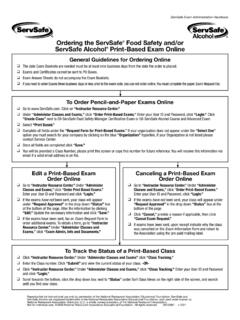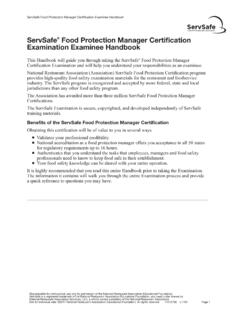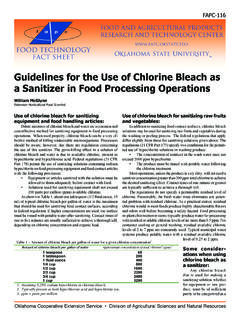Transcription of Handbook of Food Preservation - Greek Cold Storage ...
1 Handbook ofFood PreservationSecond 6/14/2007 18:12 Page iFOOD SCIENCE AND TECHNOLOGYE ditorial Advisory BoardGustavo V. Barbosa-C novasWashington State University PullmanP. Michael DavidsonUniversity of Tennessee KnoxvilleMark DreherMcNeil Nutritionals, New Brunswick, NJRichard W. HartelUniversity of Wisconsin MadisonLekh R. JunejaTaiyo Kagaku Company, JapanMarcus KarelMassachusetts Institute of Technolog yRonald G. LabbeUniversity of Massachusetts AmherstDaryl B. LundUniversity of Wisconsin MadisonDavid B. MinThe Ohio State UniversityLeo M. L. NolletHogeschool Gent, BelgiumSeppo SalminenUniversity of Turku, FinlandJohn H. Thorngate IIIA llied Domecq Technical Services, Napa, CAPieter WalstraWageningen University, The NetherlandsJohn R . WhitakerUniversity of California DavisRickey Y. YadaUniversity of Guelph, 6/14/2007 18:12 Page iiHandbook ofFood PreservationSecond Editionedited byM.
2 Shafiur RahmanCRC Press is an imprint of theTaylor & Francis Group, an informa businessBoca Raton London New 6/14/2007 18:12 Page iiiCRC PressTaylor & Francis Group6000 Broken Sound Parkway NW, Suite 300 Boca Raton, FL 33487-2742 2007 by Taylor & Francis Group, LLC CRC Press is an imprint of Taylor & Francis Group, an Informa businessNo claim to original Government worksPrinted in the United States of America on acid-free paper10 9 8 7 6 5 4 3 2 1 International Standard Book Number-10: 1-57444-606-1 (Hardcover)International Standard Book Number-13: 978-1-57444-606-7 (Hardcover)This book contains information obtained from authentic and highly regarded sources. Reprinted material is quoted with permission, and sources are indicated. A wide variety of references are listed. Reasonable efforts have been made to publish reliable data and information, but the author and the publisher cannot assume responsibility for the validity of all materials or for the consequences of their use.
3 No part of this book may be reprinted, reproduced, transmitted, or utilized in any form by any electronic, mechanical, or other means, now known or hereafter invented, including photocopying, microfilming, and recording, or in any informa-tion Storage or retrieval system, without written permission from the permission to photocopy or use material electronically from this work, please access ( ) or contact the Copyright Clearance Center, Inc. (CCC) 222 Rosewood Drive, Danvers, MA 01923, 978-750-8400. CCC is a not-for-profit organization that provides licenses and registration for a variety of users. For orga-nizations that have been granted a photocopy license by the CCC, a separate system of payment has been Notice:Product or corporate names may be trademarks or registered trademarks, and are used only for identification and explanation without intent to of Congress Cataloging-in-Publication DataHandbook of food Preservation / editor M.
4 Shafiur Rahman. -- 2nd cm. -- ( food science and technology ; 167)Includes bibliographical references and : 978-1-57444-606-7 (alk. paper)ISBN-10: 1-57444-606-1 (alk. paper)1. food -- Preservation . I. Rahman, Shafiur. II. Title. III. 2007664 .028--dc222006100043 Visit the Taylor & Francis Web site the CRC Press Web site 6/14/2007 18:12 Page 1 Preservation of Fresh food Preservation : Shafiur Physiology of Fruit and Kumar Mishra and Handling and Treatments of Fruits and Kumar Mishra and Handling of Grains and K. Mahapatra and Yubin Processing of Fruits and O. Handling and Preservation of Fresh Fish and U. Opara, Saud M. Al-Jufaili, and Mohammad Shafiur Handling of Red T. Kadim and Osman Handling of GuizaniPart 2 Preservation Using Chemicals and as a Method for food Guizani and Ann Mothershaw Antimicrobials for food J.
5 Smid and Leon G. M. in food in food Shafiur 6/14/2007 18:12 Page in food Shafiur RahmanPart 3 Preservation by Controlling Water, Structure,and Packaging of G. M. Gorris and Herman W. Transition and State Diagram of Shafiur Rahman Preservation and Processing Using S. and Caking in food R. and food Shafiur Rahman and Conrad O. Dehydration of Shafiur Activity and food Shafiur Rahman and Theodore P. Labuza Treatments and Edible Coatings in food A. , Stabilization, and Controlled Release of food Ingredients and B. Pegg and Fereidoon ShahidiPart 4 Preservation Using Heat and and food N. and Sterilization of N. and Frying of N. Preservation by Shafiur Rahman and Jorge F. Melting Process in Liquid food Shafiur Rahman, Mushtaque Ahmed, and Xiao Dong 6/14/2007 18:12 Page Pasteurization and Sterilization of Ahmed and Hosahalli S.
6 In food Processing and Torley and Bhesh R. Preservation Aspects of Ohmic Energy in food Shafiur Preservation of Shafiur Electric Fields in food Vega-Mercado, M. Marcela Gongora-Nieto,Gustavo V. Barbosa-Canovas, and Barry G. Treatment in food Palou, Aurelio Lopez-Malo, Gustavo V. Barbosa-Canovas, and Barry G. of Magnetic Field in food Ahmed and Hosahalli S. Methods for food on Hurdle Technology for Mild and Effective Preservation of LeistnerPart 5 Enhancing food Preservation by Indirect as a Preservation Shafiur of Packaging Materials Used for H. Driscoll and Mohammad Shafiur Packaging S. Sablani and Mohammad Shafiur Design and Shafiur Analysis and Critical Control Point (HACCP)..969 Titus De Manufacturing Practice (GMP)..1011 Titus De Considerations: Managing Profit and Perera and Gerard La 6/14/2007 18:12 Page 6/14/2007 18:12 Page viiiixPrefaceFood Preservation is an action or a method of maintaining foods at a desired level of properties or naturefor their maximum benefits.
7 In general, each step of handling, processing, Storage , and distributionaffects the characteristics of food , which may be desirable or undesirable. Thus, understanding the effectsof each Preservation method and handling procedure on foods is critical in food processing. The first edi-tion of this book was the first definitive source of information on food Preservation . It was well receivedby readers and became a bestseller and was also translated into Spanish by Acribia, Spain, in from scientists, academics, and industry professionals around the globe encouraged me toproduce an updated version. This edition has been developed by expanding the previous one with theaddition of new chapters and updating most of the chapters of the first edition. The 25 chapters in thefirst edition are now expanded to 44 chapters. The processing of food is no longer as simple or straightforward as in the past.
8 It is now moving froman art to a highly interdisciplinary science. A number of new Preservation techniques are being developedto satisfy current demands of economic Preservation and consumer satisfaction in nutritional and sensoryaspects, convenience, absence of preservatives, low demand of energy, and environmental safety. Betterunderstanding and manipulation of these conventional and sophisticated Preservation methods could helpto develop high-quality, safe products by better control of the processes and efficient selection of ingredi-ents. food processing needs to use Preservation techniques ranging from simple to sophisticated; thus, anyfood process must acquire requisite knowledge about the methods, the technology, and the science ofmode of action. Keeping this in mind, this edition has been developed to discuss the fundamental and prac-tical aspects of most of the food Preservation methods important to practicing industrial and academicfood scientists, technologists, and engineers.
9 Innovative technology in Preservation is being developed inthe food industry that can extend shelf life; minimize risk; is environment friendly; or can improve func-tional, sensory, and nutritional properties. The large and ever-increasing number of food products and newpreservation techniques available today creates a great demand for an up-to-date Handbook of food preser-vation methods. This book emphasizes practical, cost-effective, and safe strategies for implementingpreservation techniques and dissects the exact mode or mechanisms involved in each Preservation methodby highlighting the effect of Preservation methods on food first edition was divided into four parts. Part 1: Preservation of Fresh food Products encompassedthe overview of food Preservation and postharvest handling of foods. Part 2: Conventional FoodPreservation Methods presented comprehensive details on glass transition, water activity, drying, con-centration, freezing, irradiation, modified atmosphere, hurdle technology, and the use of natural preser-vatives, antioxidants, pH, and nitrites.
10 Part 3: Potential food Preservation Methods detailed new andinnovative Preservation techniques, such as pulsed electric fields, ohmic heating, high-pressure treat-ment, edible coating, encapsulation, light, and sound. Part 4: Enhancing food Preservation by IndirectApproach described areas that indirectly help food Preservation by improving quality and safety. Theseareas are packaging and hazard second edition is divided into five parts. The grouping of Parts 2 and 3 in the first edition couldnot be a clear approach since it was not easy to separate the conventional and the potential methods. Inthe second edition, a better rational approach is used for grouping. The basis of grouping is the mode ofpreservation 1: Preservation of Fresh food Products encompasses the overview of food Preservation and posthar-vest handling of foods, which includes physiology of fresh fruits and vegetables; handling and postharvesttreatments of fruits and vegetables; and postharvest handling of grains and pulses, fish and seafood, redmeat, milk; and also minimal processing of fruits and vegetables.





